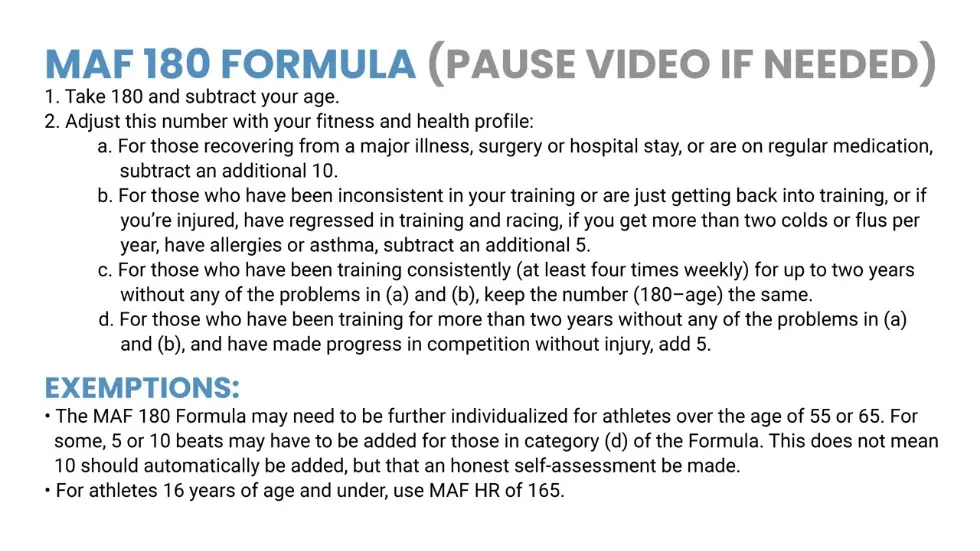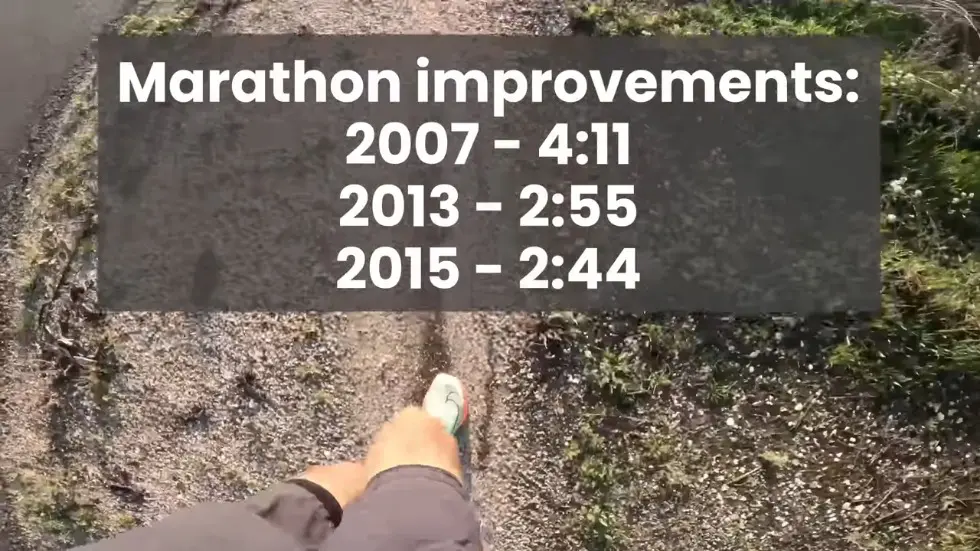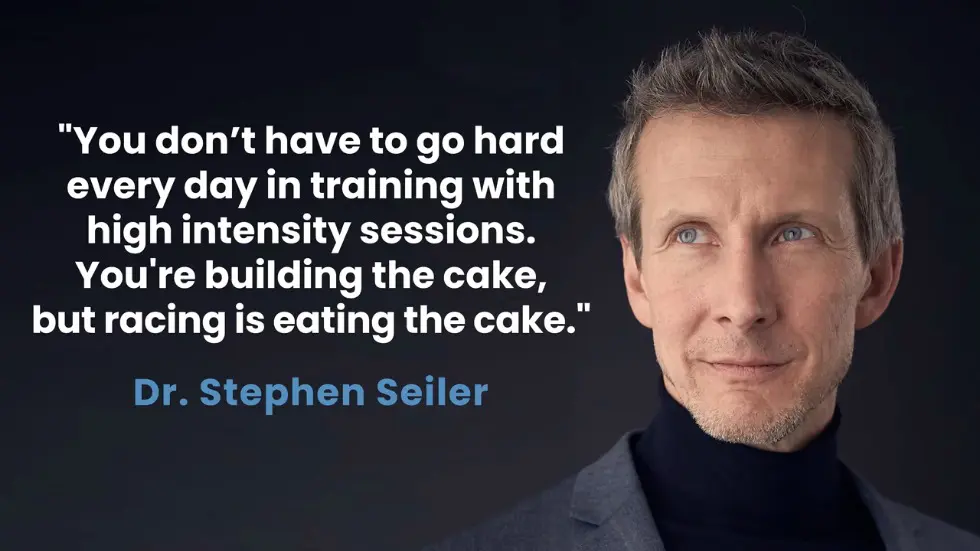10 Years of Low Heart Rate Training: Lessons From Running 17,000 Miles
Last updated: May 17, 2023
The video is about the speaker's 10 years of experience with low heart rate training, including lessons learned and different methods for calculating and personalizing training zones.
The video is about the speaker's experience with low heart rate training over the past 10 years, during which he has run 17,000 miles.
He explains the concept of maximum aerobic function (MAF) and how improving one's fat burning abilities can be achieved through low heart rate training, nutrition, stress management, and sleep.
He also discusses different methods for calculating one's low heart rate training zone, including the 180 formula, and emphasizes the importance of personalization based on an individual's health and fitness profile.
The speaker shares his own humbling experience starting out with low heart rate training and offers advice for athletes who may be struggling with this approach.
- The speaker shares lessons learned from 10 years of low heart rate training and running 17,000 miles.
- Improving fat burning abilities can be done through low heart rate training, nutrition, stress management, and sleep.
- There are different methods for calculating low heart rate training zone, including the 180 formula.
- Personalization may be needed for athletes with exceptionally high max heart rate or over the age of 55 or 65.
- Low heart rate training requires patience and persistence, but the benefits are worth it.
- Dr. Phil Maffetone recommends adding in some speed work after plateauing or improving for 3-6 months.
- Consistency of being injury-free and recovering well helped stack improvements over time.
- Journaling is a powerful tool for tracking progress and recognizing patterns.
- Rest and sleep are essential for recovery and improvement, and stress levels impact all aspects of life, including running performance.
10 Years of Low Heart Rate Training: Lessons From Running 17,000 Miles - YouTube

Introduction
- The speaker is going to share lessons learned from 10 years of low heart rate training.
- He has run 17,000 miles using this training method.
- The plan for the day is to run a 3-hour marathon.
- The concept of training slower to race faster was introduced to the speaker by Dr. Phil Maffetone on a podcast.

Calculating Low Heart Rate Training Zone
- Improving fat burning abilities can be done through low heart rate training, nutrition, stress management, and sleep.
- There are different methods for calculating low heart rate training zone, including heart rate calculator, torque test, and blood lactate test.
- The 180 formula is a popular method developed by Dr. Phil Maffetone.
- The formula is 180 minus age, adjusted with health and fitness profile.
- Personalization may be needed for athletes with exceptionally high max heart rate or over the age of 55 or 65.

Personalization and Experimentation
- The 180 formula may not be accurate for everyone, and further personalization may be needed.
- Athletes can experiment with other methods, such as breathing test, resting and max heart rate test, and blood lactate test.
- The 180 formula and MAF approach take the athlete's health and fitness profile into account.
- Training intensity should be adjusted based on the athlete's current condition and progress.
- Personalization is based on the individual athlete, which is a benefit of this training method.

10 Years of Low Heart Rate Training: Lessons From Running 17,000 Miles - YouTube
Challenges and Frustrations
- The speaker's first experience with low heart rate training was humbling, as he had to slow down significantly.
- Many athletes starting out with this training approach experience disbelief and frustration at their fitness level.
- This frustration is common among podcast guests, members of the speaker's community, and coaching program participants.
- Slowing down by several minutes per mile is necessary for many athletes to stay within their low heart rate training zone.
- Low heart rate training requires patience and persistence, but the benefits are worth it.

Early Stages of Low Heart Rate Training
- Initially frustrated with having to slow down significantly due to heart rate.
- Changed watch settings to focus on heart rate and time spent in training zone.
- Benefits included improved energy levels, disappearance of muscle aches, increased awareness of surroundings, improved sleep quality, and better nutritional intake.
- Started thinking long-term and stopped caring about running and walking pace.
- Noticed improvements in pace after four weeks of low heart rate training.

Adding in Speed Work
- Low heart rate training is not just training at low heart rate.
- Dr. Phil Maffetone recommends adding in some speed work after plateauing or improving for 3-6 months.
- Most people respond well when 80% of their training is at or under math and 15-20% is anaerobic.
- Started adding in speed work after three months of low heart rate training.
- Gradually improved math base from 8:21 to 6:12 minute mile over two years.

Training Volume and Consistency
- Ran 17,095 miles in 2,586 hours over 10 years.
- More than 90% of training was at low intensity and less than 10% was high intensity.
- Consistency of being injury-free and recovering well helped stack improvements over time.
- Aerobic development takes a long time, but consistency over long periods of time leads to gradual improvement.
- Training volume was only five hours per week or 42 minutes per day on average.

Lessons Learned from Low Heart Rate Training
- Patience is key in low heart rate training.
- Focus on heart rate and time spent in training zone rather than pace.
- Slow jogging and walking is also training.
- Pay attention to signals from your body.
- Long-term thinking is important for improvement.
- Consistency and injury-free training lead to gradual improvement over time.

Benefits of Low Heart Rate Training
- Improvement in endurance and aerobic capacity
- Lower risk of injury compared to other training methods
- Consistent training leads to long-term improvements
- Allows for balance with other responsibilities in life
- Brings joy and relaxation to everyday life

The Power of Journaling
- Journaling is a powerful tool for tracking progress and recognizing patterns
- Write down details about training, gear, nutrition, and stress management
- Consistency in journaling is more important than the amount of detail
- Rest and sleep are crucial for recovery and improvement
- Stress levels impact all aspects of life, including running performance

The Importance of Rest, Sleep, and Relaxation
- Rest and sleep are essential for recovery and improvement
- Stress levels impact all aspects of life, including running performance
- Relaxation and discipline in training and life lead to better results
- Proper nutrition plays a significant role in energy levels, performance, and recovery
- Consistent training and nutrition lead to weight loss and improved functioning of the body

Avoiding Comparison and Focusing on Consistency
- Comparison leads to unhappiness, focus on personal progress
- Every athlete is different, with varying genetics, priorities, and motivations
- Consistent movement and training lead to improvements in various parts of life
- Be proud of progress, no matter how small

Factors Affecting Low Heart Rate Training
- Low heart rate training may not work if other factors affecting performance are not addressed.
- Factors to consider include sleep, recovery, stress levels, and nutrition.
- Improving sleep can lead to significant improvements in performance.
- During base building phase, occasional higher heart rate runs are acceptable.
- Balance is key in lowering intensity while keeping runs exciting.

Importance of High Intensity Training
- High intensity training should be added to low heart rate training at some point.
- Benefits of high intensity training include getting used to race day pace, faster turnover, and developing fast twitch muscle fibers.
- Developing an aerobic base should come first before adding speed work.
- Don't overdo high intensity training as it can add too much stress on the body and block aerobic progress.
- Building the cake through training, but racing is eating the cake.

Flexibility in Training
- Training schedules should be adjusted based on daily circumstances.
- Adjustments can be made to duration or intensity of runs.
- Flexibility allows for adjustments based on how rested or energized an athlete feels.
- Training schedules should not be set in stone.
- Flexibility allows for better recovery and performance.

Low Heart Rate Training Works for Everyone
- Low heart rate training can work for beginners, intermediate, and advanced athletes.
- It can work for athletes of all ages, from younger athletes to those in their 50s, 60s, and 70s.
- Low heart rate training can lead to significant improvements in performance.
- It is important to find the right balance between low intensity and high intensity training.
- Low heart rate training can be a sustainable and effective training method for long-term success.

Benefits of Low Heart Rate Training
- Low intensity running followed by high intensity running helps in building a strong base and gradually increasing running intensity.
- Personalization might be needed with heart rate zones for ultra distances, but the concept of low intensity running works for everyone.
- Low heart rate training helps in avoiding injuries and burnout, which are common in 80 20 running or normal training schedules.
- Progress takes time and is not linear, so consistency and patience are important.
- The speaker has been low intensity training with some high intensity for 10 years and will continue training this way for the rest of his life.
- Listeners can check out more stories from Extra Mile Podcast guests at extramilest.com podcast and learn more about the speaker's PB Running Coaching Program at pbprogram.com.
Watch the video on YouTube:
10 Years of Low Heart Rate Training: Lessons From Running 17,000 Miles - YouTube
